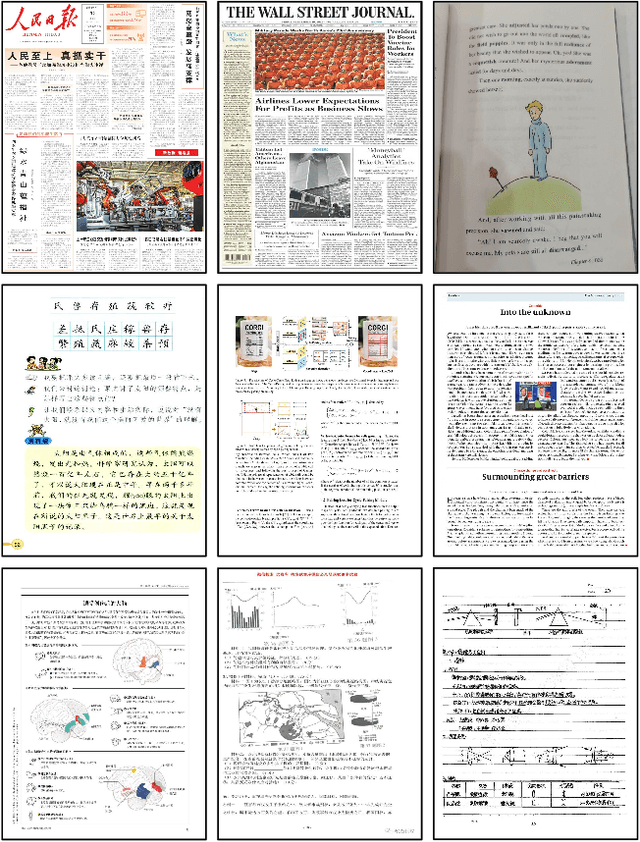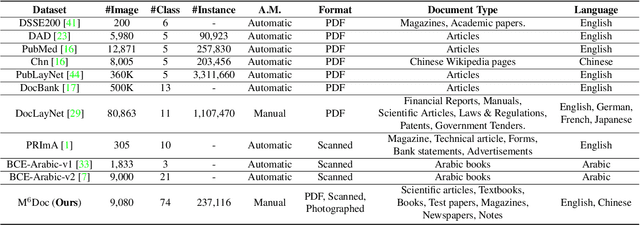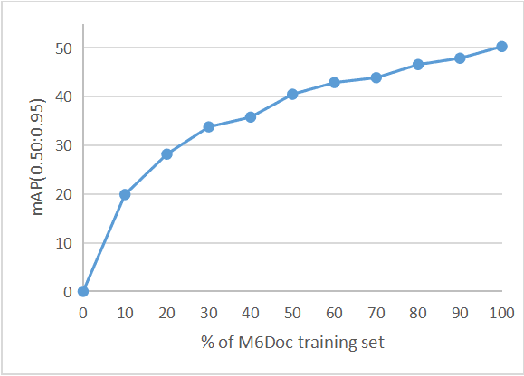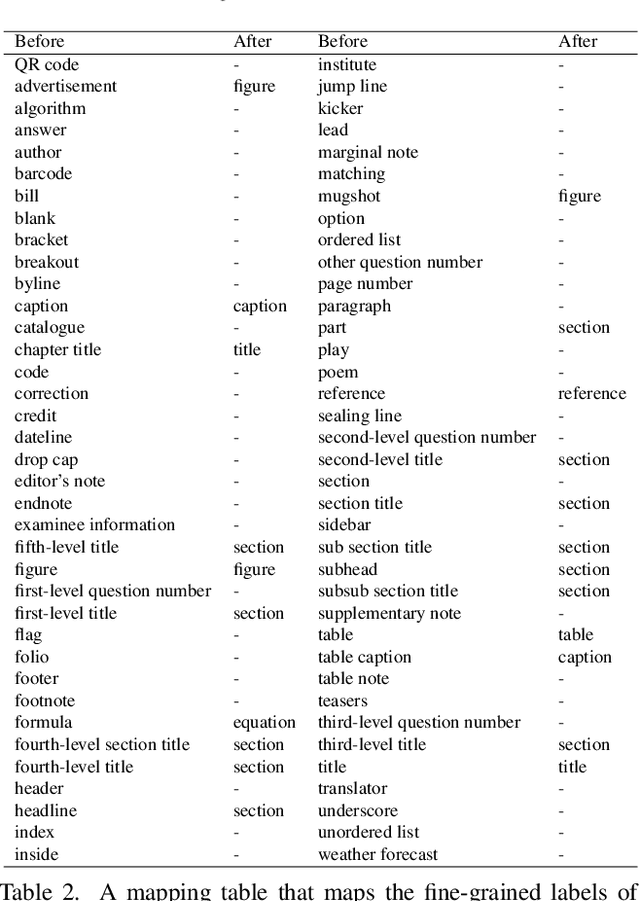Peirong Zhang
MegaHan97K: A Large-Scale Dataset for Mega-Category Chinese Character Recognition with over 97K Categories
Jun 05, 2025Abstract:Foundational to the Chinese language and culture, Chinese characters encompass extraordinarily extensive and ever-expanding categories, with the latest Chinese GB18030-2022 standard containing 87,887 categories. The accurate recognition of this vast number of characters, termed mega-category recognition, presents a formidable yet crucial challenge for cultural heritage preservation and digital applications. Despite significant advances in Optical Character Recognition (OCR), mega-category recognition remains unexplored due to the absence of comprehensive datasets, with the largest existing dataset containing merely 16,151 categories. To bridge this critical gap, we introduce MegaHan97K, a mega-category, large-scale dataset covering an unprecedented 97,455 categories of Chinese characters. Our work offers three major contributions: (1) MegaHan97K is the first dataset to fully support the latest GB18030-2022 standard, providing at least six times more categories than existing datasets; (2) It effectively addresses the long-tail distribution problem by providing balanced samples across all categories through its three distinct subsets: handwritten, historical and synthetic subsets; (3) Comprehensive benchmarking experiments reveal new challenges in mega-category scenarios, including increased storage demands, morphologically similar character recognition, and zero-shot learning difficulties, while also unlocking substantial opportunities for future research. To the best of our knowledge, the MetaHan97K is likely the dataset with the largest classes not only in the field of OCR but may also in the broader domain of pattern recognition. The dataset is available at https://github.com/SCUT-DLVCLab/MegaHan97K.
Online Signature Verification based on the Lagrange formulation with 2D and 3D robotic models
Mar 17, 2025Abstract:Online Signature Verification commonly relies on function-based features, such as time-sampled horizontal and vertical coordinates, as well as the pressure exerted by the writer, obtained through a digitizer. Although inferring additional information about the writers arm pose, kinematics, and dynamics based on digitizer data can be useful, it constitutes a challenge. In this paper, we tackle this challenge by proposing a new set of features based on the dynamics of online signatures. These new features are inferred through a Lagrangian formulation, obtaining the sequences of generalized coordinates and torques for 2D and 3D robotic arm models. By combining kinematic and dynamic robotic features, our results demonstrate their significant effectiveness for online automatic signature verification and achieving state-of-the-art results when integrated into deep learning models.
Privacy-Preserving Biometric Verification with Handwritten Random Digit String
Mar 17, 2025Abstract:Handwriting verification has stood as a steadfast identity authentication method for decades. However, this technique risks potential privacy breaches due to the inclusion of personal information in handwritten biometrics such as signatures. To address this concern, we propose using the Random Digit String (RDS) for privacy-preserving handwriting verification. This approach allows users to authenticate themselves by writing an arbitrary digit sequence, effectively ensuring privacy protection. To evaluate the effectiveness of RDS, we construct a new HRDS4BV dataset composed of online naturally handwritten RDS. Unlike conventional handwriting, RDS encompasses unconstrained and variable content, posing significant challenges for modeling consistent personal writing style. To surmount this, we propose the Pattern Attentive VErification Network (PAVENet), along with a Discriminative Pattern Mining (DPM) module. DPM adaptively enhances the recognition of consistent and discriminative writing patterns, thus refining handwriting style representation. Through comprehensive evaluations, we scrutinize the applicability of online RDS verification and showcase a pronounced outperformance of our model over existing methods. Furthermore, we discover a noteworthy forgery phenomenon that deviates from prior findings and discuss its positive impact in countering malicious impostor attacks. Substantially, our work underscores the feasibility of privacy-preserving biometric verification and propels the prospects of its broader acceptance and application.
Smaller But Better: Unifying Layout Generation with Smaller Large Language Models
Feb 19, 2025Abstract:We propose LGGPT, an LLM-based model tailored for unified layout generation. First, we propose Arbitrary Layout Instruction (ALI) and Universal Layout Response (ULR) as the uniform I/O template. ALI accommodates arbitrary layout generation task inputs across multiple layout domains, enabling LGGPT to unify both task-generic and domain-generic layout generation hitherto unexplored. Collectively, ALI and ULR boast a succinct structure that forgoes superfluous tokens typically found in existing HTML-based formats, facilitating efficient instruction tuning and boosting unified generation performance. In addition, we propose an Interval Quantization Encoding (IQE) strategy that compresses ALI into a more condensed structure. IQE precisely preserves valid layout clues while eliminating the less informative placeholders, facilitating LGGPT to capture complex and variable layout generation conditions during the unified training process. Experimental results demonstrate that LGGPT achieves superior or on par performance compared to existing methods. Notably, LGGPT strikes a prominent balance between proficiency and efficiency with a compact 1.5B parameter LLM, which beats prior 7B or 175B models even in the most extensive and challenging unified scenario. Furthermore, we underscore the necessity of employing LLMs for unified layout generation and suggest that 1.5B could be an optimal parameter size by comparing LLMs of varying scales. Code is available at https://github.com/NiceRingNode/LGGPT.
Online Writer Retrieval with Chinese Handwritten Phrases: A Synergistic Temporal-Frequency Representation Learning Approach
Dec 16, 2024



Abstract:Currently, the prevalence of online handwriting has spurred a critical need for effective retrieval systems to accurately search relevant handwriting instances from specific writers, known as online writer retrieval. Despite the growing demand, this field suffers from a scarcity of well-established methodologies and public large-scale datasets. This paper tackles these challenges with a focus on Chinese handwritten phrases. First, we propose DOLPHIN, a novel retrieval model designed to enhance handwriting representations through synergistic temporal-frequency analysis. For frequency feature learning, we propose the HFGA block, which performs gated cross-attention between the vanilla temporal handwriting sequence and its high-frequency sub-bands to amplify salient writing details. For temporal feature learning, we propose the CAIR block, tailored to promote channel interaction and reduce channel redundancy. Second, to address data deficit, we introduce OLIWER, a large-scale online writer retrieval dataset encompassing over 670,000 Chinese handwritten phrases from 1,731 individuals. Through extensive evaluations, we demonstrate the superior performance of DOLPHIN over existing methods. In addition, we explore cross-domain writer retrieval and reveal the pivotal role of increasing feature alignment in bridging the distributional gap between different handwriting data. Our findings emphasize the significance of point sampling frequency and pressure features in improving handwriting representation quality and retrieval performance. Code and dataset are available at https://github.com/SCUT-DLVCLab/DOLPHIN.
TongGu: Mastering Classical Chinese Understanding with Knowledge-Grounded Large Language Models
Jul 04, 2024Abstract:Classical Chinese is a gateway to the rich heritage and wisdom of ancient China, yet its complexities pose formidable comprehension barriers for most modern people without specialized knowledge. While Large Language Models (LLMs) have shown remarkable capabilities in Natural Language Processing (NLP), they struggle with Classical Chinese Understanding (CCU), especially in data-demanding and knowledge-intensive tasks. In response to this dilemma, we propose \textbf{TongGu} (mean understanding ancient and modern), the first CCU-specific LLM, underpinned by three core contributions. First, we construct a two-stage instruction-tuning dataset ACCN-INS derived from rich classical Chinese corpora, aiming to unlock the full CCU potential of LLMs. Second, we propose Redundancy-Aware Tuning (RAT) to prevent catastrophic forgetting, enabling TongGu to acquire new capabilities while preserving its foundational knowledge. Third, we present a CCU Retrieval-Augmented Generation (CCU-RAG) technique to reduce hallucinations based on knowledge-grounding. Extensive experiments across 24 diverse CCU tasks validate TongGu's superior ability, underscoring the effectiveness of RAT and CCU-RAG. The model and dataset will be public available.
DocRes: A Generalist Model Toward Unifying Document Image Restoration Tasks
May 07, 2024



Abstract:Document image restoration is a crucial aspect of Document AI systems, as the quality of document images significantly influences the overall performance. Prevailing methods address distinct restoration tasks independently, leading to intricate systems and the incapability to harness the potential synergies of multi-task learning. To overcome this challenge, we propose DocRes, a generalist model that unifies five document image restoration tasks including dewarping, deshadowing, appearance enhancement, deblurring, and binarization. To instruct DocRes to perform various restoration tasks, we propose a novel visual prompt approach called Dynamic Task-Specific Prompt (DTSPrompt). The DTSPrompt for different tasks comprises distinct prior features, which are additional characteristics extracted from the input image. Beyond its role as a cue for task-specific execution, DTSPrompt can also serve as supplementary information to enhance the model's performance. Moreover, DTSPrompt is more flexible than prior visual prompt approaches as it can be seamlessly applied and adapted to inputs with high and variable resolutions. Experimental results demonstrate that DocRes achieves competitive or superior performance compared to existing state-of-the-art task-specific models. This underscores the potential of DocRes across a broader spectrum of document image restoration tasks. The source code is publicly available at https://github.com/ZZZHANG-jx/DocRes
HierCode: A Lightweight Hierarchical Codebook for Zero-shot Chinese Text Recognition
Mar 20, 2024Abstract:Text recognition, especially for complex scripts like Chinese, faces unique challenges due to its intricate character structures and vast vocabulary. Traditional one-hot encoding methods struggle with the representation of hierarchical radicals, recognition of Out-Of-Vocabulary (OOV) characters, and on-device deployment due to their computational intensity. To address these challenges, we propose HierCode, a novel and lightweight codebook that exploits the innate hierarchical nature of Chinese characters. HierCode employs a multi-hot encoding strategy, leveraging hierarchical binary tree encoding and prototype learning to create distinctive, informative representations for each character. This approach not only facilitates zero-shot recognition of OOV characters by utilizing shared radicals and structures but also excels in line-level recognition tasks by computing similarity with visual features, a notable advantage over existing methods. Extensive experiments across diverse benchmarks, including handwritten, scene, document, web, and ancient text, have showcased HierCode's superiority for both conventional and zero-shot Chinese character or text recognition, exhibiting state-of-the-art performance with significantly fewer parameters and fast inference speed.
M$^{6}$Doc: A Large-Scale Multi-Format, Multi-Type, Multi-Layout, Multi-Language, Multi-Annotation Category Dataset for Modern Document Layout Analysis
May 21, 2023



Abstract:Document layout analysis is a crucial prerequisite for document understanding, including document retrieval and conversion. Most public datasets currently contain only PDF documents and lack realistic documents. Models trained on these datasets may not generalize well to real-world scenarios. Therefore, this paper introduces a large and diverse document layout analysis dataset called $M^{6}Doc$. The $M^6$ designation represents six properties: (1) Multi-Format (including scanned, photographed, and PDF documents); (2) Multi-Type (such as scientific articles, textbooks, books, test papers, magazines, newspapers, and notes); (3) Multi-Layout (rectangular, Manhattan, non-Manhattan, and multi-column Manhattan); (4) Multi-Language (Chinese and English); (5) Multi-Annotation Category (74 types of annotation labels with 237,116 annotation instances in 9,080 manually annotated pages); and (6) Modern documents. Additionally, we propose a transformer-based document layout analysis method called TransDLANet, which leverages an adaptive element matching mechanism that enables query embedding to better match ground truth to improve recall, and constructs a segmentation branch for more precise document image instance segmentation. We conduct a comprehensive evaluation of $M^{6}Doc$ with various layout analysis methods and demonstrate its effectiveness. TransDLANet achieves state-of-the-art performance on $M^{6}Doc$ with 64.5% mAP. The $M^{6}Doc$ dataset will be available at https://github.com/HCIILAB/M6Doc.
MSDS: A Large-Scale Chinese Signature and Token Digit String Dataset for Handwriting Verification
Oct 17, 2022



Abstract:Although online handwriting verification has made great progress recently, the verification performances are still far behind the real usage owing to the small scale of the datasets as well as the limited biometric mediums. Therefore, this paper proposes a new handwriting verification benchmark dataset named Multimodal Signature and Digit String (MSDS), which consists of two subsets: MSDS-ChS (Chinese Signatures) and MSDS-TDS (Token Digit Strings), contributed by 402 users, with 20 genuine samples and 20 skilled forgeries per user per subset. MSDS-ChS consists of handwritten Chinese signatures, which, to the best of our knowledge, is the largest publicly available Chinese signature dataset for handwriting verification, at least eight times larger than existing online datasets. Meanwhile, MSDS-TDS consists of handwritten Token Digit Strings, i.e, the actual phone numbers of users, which have not been explored yet. Extensive experiments with different baselines are respectively conducted for MSDS-ChS and MSDS-TDS. Surprisingly, verification performances of state-of-the-art methods on MSDS-TDS are generally better than those on MSDS-ChS, which indicates that the handwritten Token Digit String could be a more effective biometric than handwritten Chinese signature. This is a promising discovery that could inspire us to explore new biometric traits. The MSDS dataset is available at https://github.com/HCIILAB/MSDS.
 Add to Chrome
Add to Chrome Add to Firefox
Add to Firefox Add to Edge
Add to Edge